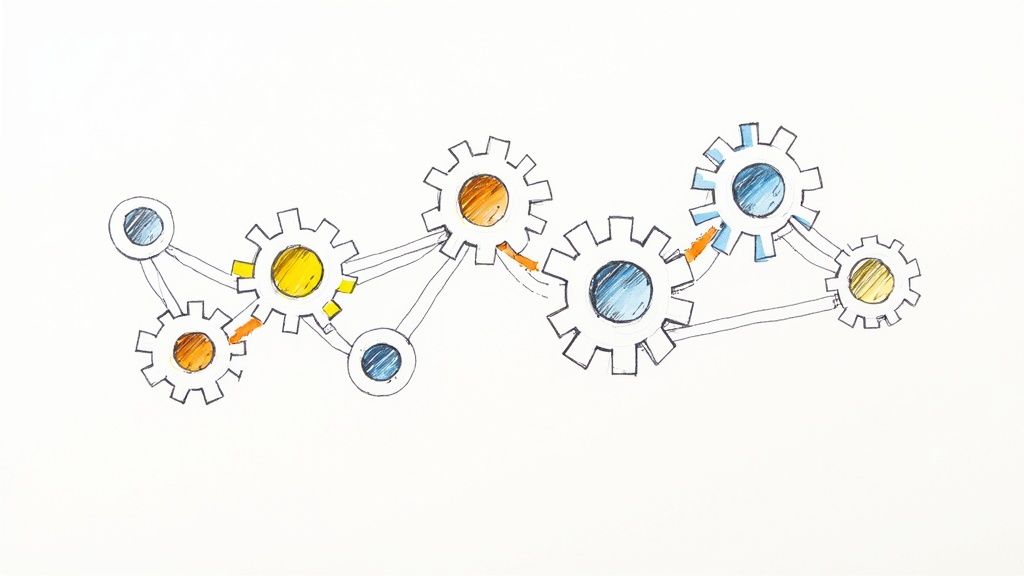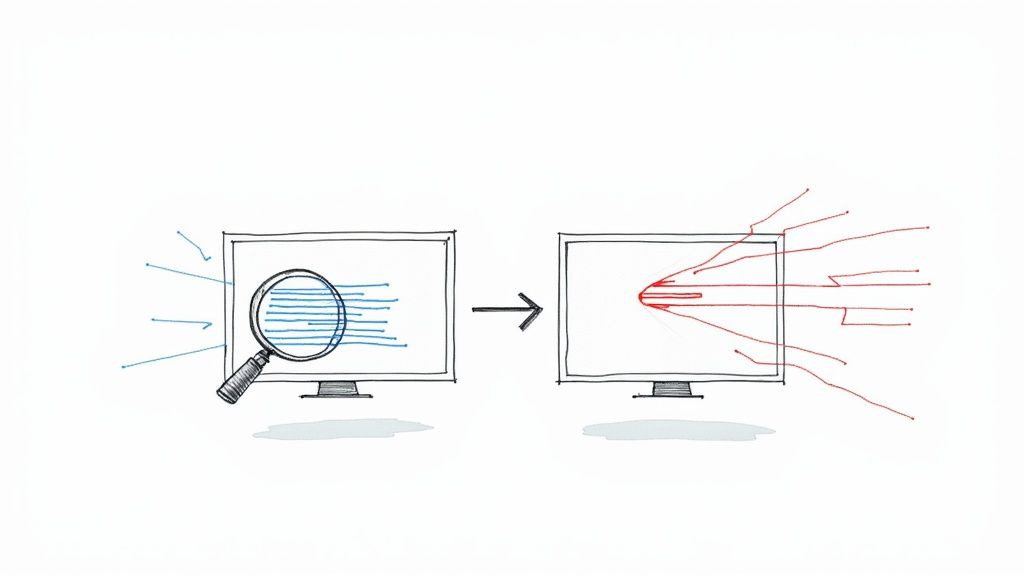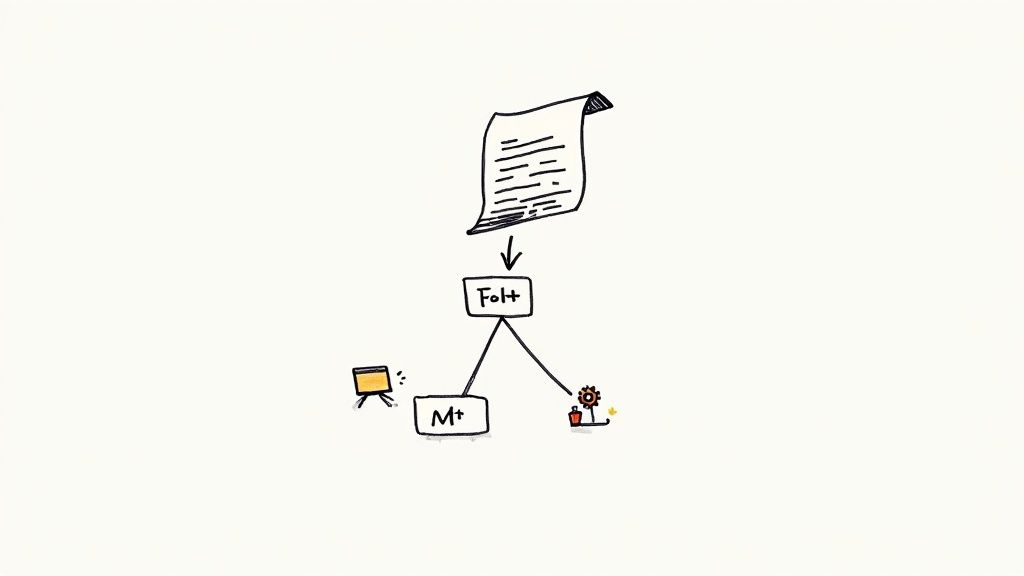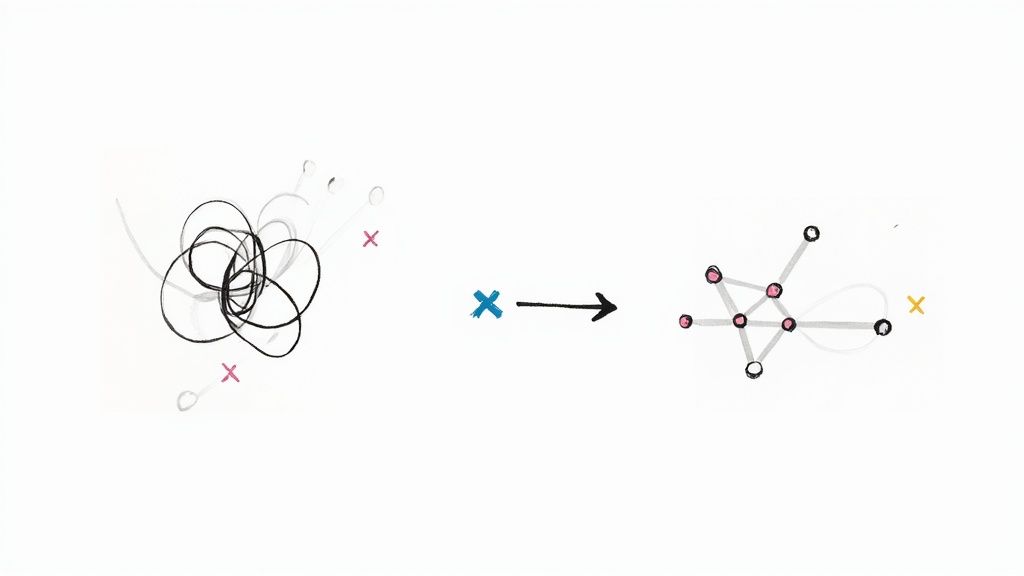5 Ways to Improve Developer Productivity

The Reality of Developer Productivity Today

The software development world moves quickly. Innovation and rapid delivery are constant demands. This puts a lot of pressure on developers to be highly productive. However, how do we measure that productivity? Traditional metrics, like lines of code or number of bugs fixed, often miss the mark.
These metrics don't capture the complexities of software development. They can even encourage the wrong behaviors. For example, focusing on lines of code can lead to bloated, inefficient codebases. A focus on bug fixes might mean neglecting proactive quality measures.
The economic landscape for developers has also shifted. This changes how we discuss developer productivity. While median developer salaries have increased by 24%, this is less than the 30% growth across all U.S. workers. Developer employment numbers have also fluctuated, with declines in recent years. This changing landscape requires a new look at how we approach and improve developer productivity. You can find more detailed statistics in this article: The Rise and Fall of the Software Developer.
The Challenge of Traditional Metrics
Many organizations still rely on outdated methods for evaluating developer performance. These methods focus on easily measured, but ultimately superficial, metrics.
- Time Tracking: Simply tracking hours worked doesn't account for the deep, focused thinking required for complex problem-solving.
- Ticket Closure Rate: Closing tickets is important. However, prioritizing speed over quality can lead to technical debt and future problems.
- Code Reviews Completed: A high volume of code reviews doesn't mean they're thorough or provide meaningful feedback.
These traditional metrics don't show the complete picture of a developer's contribution. They can even create a culture of anxiety and burnout.
Embracing a New Approach
Forward-thinking organizations are moving away from these old metrics. They're adopting a more holistic view of developer productivity. This means focusing on outcomes, collaboration, and sustainable practices.
Prioritizing quality over quantity is key. So is fostering a supportive team environment. Providing developers with the right tools and resources is also crucial. By doing these things, organizations can unlock their team's true potential and achieve long-term success. This opens the door to exploring new metrics and strategies that truly improve developer effectiveness and well-being.
Measuring What Actually Matters: New Productivity Metrics

As we've discussed, traditional developer productivity metrics often miss the mark. Simply counting lines of code or tracking hours worked doesn't accurately reflect a developer's true contribution. So, how do successful engineering organizations measure what truly counts? They're shifting away from these outdated methods and embracing a more insightful approach.
Focusing on Business Impact
Effective productivity measurement begins by connecting metrics to business objectives. This means concentrating on results that directly contribute to the company's overall success.
For example, instead of measuring the number of features shipped, consider tracking the effect of those features on user engagement or revenue generation. This change in perspective helps developers see the bigger picture and understand their role in it.
Measuring Developer Satisfaction
A happy developer is often a productive developer. This means prioritizing and enhancing developer satisfaction is essential for boosting performance. Factors such as effective team dynamics, access to necessary resources, and opportunities for professional growth all contribute to a positive experience.
By monitoring these factors, organizations can cultivate a supportive work environment that encourages productivity.
The Role of Context
Every project has unique characteristics. A uniform approach to productivity measurement won't work. Elements such as project complexity, the team's experience level, and the technologies being used should all inform the metrics you choose.
For example, a team tackling a complex new feature might initially progress slower than a team maintaining existing code.
It can be difficult to measure developer productivity, and often involves looking at historical data. However, traditional methods, such as considering employee tenure or using the "last in, first out" principle for layoffs, may not be effective indicators of individual performance. More modern metrics, like commit counts, lines of code changed, or delta changes, might provide a clearer understanding of effort and output. To delve deeper into this topic, check out this resource: Measuring Developer Productivity.
Practical Implementation Frameworks
Introducing new productivity metrics doesn't need to be overwhelming. Begin by selecting a few key metrics that align with both your business objectives and the team's specific situation.
Then, monitor these metrics over time and use the data to find areas for improvement. Open communication with your team about the new metrics and their purpose is crucial. This transparency builds trust and ensures everyone understands the goals.
Modern Metrics in Action
To illustrate the differences, let's look at a comparison of traditional and modern productivity metrics. The following table offers a summary of these approaches:
Traditional vs. Modern Developer Productivity Metrics: This table compares outdated productivity measurements with more effective modern approaches to evaluating developer performance.
| Traditional Metrics | Limitations | Modern Metrics | Benefits |
|---|---|---|---|
| Lines of Code | Doesn’t reflect code quality or complexity | Impact on Key Business Metrics (e.g., conversion rates) | Directly tied to business value |
| Hours Worked | Doesn't account for efficiency or focused work | Cycle Time (time to complete a task) | Measures efficiency and identifies bottlenecks |
| Bug Fix Rate | Can incentivize reactive rather than proactive work | Team Velocity (consistent delivery pace) | Focuses on sustainable output and predictability |
By embracing these modern metrics, engineering organizations gain a more comprehensive and accurate understanding of developer productivity. This ultimately leads to improved performance, increased team satisfaction, and, most importantly, better business outcomes. This sets the stage for exploring how tools like Mergify can further enhance development workflows and boost productivity.
Transforming Development With AI: Beyond the Hype

The excitement surrounding AI coding tools is palpable. However, distinguishing actual productivity improvements from marketing spin requires careful consideration. We need to look past the promises and examine the real impact of AI on development workflows. This section explores how AI can genuinely boost developer productivity, focusing on practical application and quantifiable outcomes.
Real-World Impacts of AI on Development
AI tools are reshaping how developers work, providing support for tasks like code completion, bug detection, and even code generation. AI-powered code completion tools, for instance, can drastically reduce the time spent looking up syntax or recalling specific function calls.
This frees developers to concentrate on the logic and architecture of their code, instead of getting stuck on minor details. Moreover, AI can identify potential bugs and security flaws early in the development cycle, avoiding expensive fixes down the line.
Boosting developer productivity often means using these AI tools strategically. Studies examining massive codebases – over 211 million lines of code spanning a five-year period and encompassing 878,592 developer-years – offer valuable insights into how AI assistants improve code quality and overall developer productivity. For a deeper dive into these statistics, check out this resource: How to Measure Developer Productivity and Other Measurement Research. This data-driven approach helps separate the hype from the true advantages of AI in software development.
Integrating AI Tools Effectively
Successfully incorporating AI tools into development workflows demands a strategic plan. This begins with choosing the right tools for the team's and the project's specific requirements. Not every AI tool is universally applicable, and some might even hinder productivity if implemented incorrectly.
For example, an overly ambitious code generation tool could produce code that's difficult to understand or maintain. Thorough evaluation and careful selection are essential.
Furthermore, training developers on how to effectively utilize these tools is vital. Simply granting access isn't sufficient. Developers must understand how to leverage AI capabilities to maximize their own productivity. This includes understanding the tool's limitations and knowing when to rely on their own judgment.
Leveraging AI Across Different Roles
AI's influence on developer productivity extends to various roles within a development team. Junior developers can benefit from AI-powered code completion and debugging support, enabling them to learn more quickly and contribute more effectively. Senior developers can use AI to automate repetitive tasks and concentrate on more intricate challenges. Even software architects can use AI to explore different design possibilities and optimize system performance.
This targeted application of AI, tailored to individual roles and responsibilities, ensures everyone on the team gains from the technology.
Measuring the ROI of AI Investments
Validating the investment in AI tools requires demonstrating a clear return on investment (ROI). This means monitoring key metrics, such as time saved on specific tasks, the reduction in bug rates, and the overall improvement in code quality.
These metrics offer concrete proof of AI's impact on developer productivity and inform organizational decisions about future AI investments. Tools like Mergify can be especially useful in this context, providing features that streamline workflows and enhance code quality, leading to measurable productivity gains. Learn more about how Mergify can boost your team's efficiency.
Creating Environments Where Developers Thrive

A developer's environment significantly impacts their productivity. This includes both their physical setup and the digital tools at their disposal. A key factor in unlocking a developer's full potential lies in creating an environment that minimizes distractions and encourages focus. This means considering everything from the comfort of their workspace to the efficiency of their CI/CD pipeline.
The Physical Workspace: Ergonomics and Flow
A comfortable and well-designed workspace isn't just a nice-to-have; it's a strategic investment in developer productivity. Ergonomic factors, such as proper desk height and monitor placement, play a vital role in reducing physical strain and improving focus.
Offering developers choices in their workspaces, like standing desks or quiet zones, can cater to individual needs and foster a sense of control. This sense of control contributes to a deeper state of flow, allowing developers to truly immerse themselves in their work.
The Digital Workspace: Tools and Technologies
Just as crucial as the physical workspace is the digital environment. This encompasses the hardware developers use, the software they code with, and the tools that support their workflow. High-performance computers, multiple monitors, and comfortable keyboards can greatly enhance a developer's daily experience.
Access to up-to-date development tools and technologies also empowers developers to work efficiently and produce higher-quality code.
Providing developers with robust IDEs like IntelliJ IDEA and efficient debugging tools can streamline the development process. This allows them to dedicate more time to crafting innovative solutions, rather than wrestling with their tools. Furthermore, tools like Mergify can automate tedious tasks related to code integration and deployment, freeing developers to focus on writing great code. Learn more about how Mergify can optimize your team's CI/CD pipeline and boost developer productivity.
Minimizing Disruptions: Context Switching and Notifications
Context switching is a major obstacle to developer productivity. Each interruption, whether it's a meeting, an email, or a Slack message, disrupts a developer's flow state. Regaining focus after each interruption takes time and mental energy.
Minimizing these distractions is essential for creating a thriving developer environment. Strategies such as designated "focus time" blocks or tools that manage notifications and communication effectively can significantly reduce disruptions.
Tailoring Environments: Roles and Work Styles
Different developer roles and individual work styles necessitate different environmental considerations. A front-end developer focusing on UI/UX might prefer a bright, collaborative space, while a back-end developer tackling complex algorithms might value a quiet, private office.
Recognizing and accommodating these differences is key to creating an environment where everyone feels comfortable and performs at their best. This adaptability not only improves developer productivity but also cultivates a more positive and supportive team culture.
Building Teams That Amplify Individual Productivity
A talented developer working alone can only accomplish so much. Real productivity gains originate from well-structured teams that empower individuals to excel. This section explores how team composition, communication, and collaborative practices significantly influence productivity.
Structuring Teams for Success
Successful engineering organizations know that team structure is paramount. It's a delicate balance between providing developers with autonomy and ensuring alignment with project objectives. One effective strategy is creating small, focused teams dedicated to specific product areas.
This cultivates ownership and reduces dependencies between teams. Clearly defined roles and responsibilities within each team also minimize confusion and facilitate efficient collaboration. A well-defined team structure, like clean, organized code, improves efficiency and output.
Optimizing Communication and Collaboration
Open and efficient communication is essential for any successful development team. Implement tools and practices that promote transparent dialogue and feedback. For instance, daily stand-up meetings keep everyone informed about progress and obstacles.
Regular code reviews, when conducted constructively, encourage knowledge sharing and elevate code quality. These practices, much like database query optimization, decrease latency and boost overall performance. Tools like Mergify can streamline code review and integration, creating a smoother collaborative workflow.
Fostering Knowledge Sharing Without Wasting Time
Knowledge sharing is crucial but shouldn't consume excessive time. Structured knowledge bases and comprehensive internal documentation enable developers to find answers quickly without interrupting teammates.
Pair programming and mentoring programs are also effective for knowledge transfer between team members. These initiatives build team cohesion and reduce reliance on individual experts as single points of knowledge.
Identifying and Addressing Team Dynamics Challenges
Even well-structured teams with the right tools can face challenges. It’s important to recognize warning signs of dysfunctional team dynamics, such as excessive conflict, poor communication, or a lack of trust.
Address these issues proactively. Team-building activities or external coaching can mediate conflicts and improve communication. Think of it like debugging: identify the problem's root cause and apply the appropriate solutions to restore healthy team function.
Collaboration Models for Different Contexts
Different development environments call for different collaboration models. A fast-paced startup might benefit from a flexible Agile approach. A large enterprise, however, might need a more structured approach for complex projects.
Consider these contextual differences when selecting a collaboration model. Experiment and adapt to find the best fit. Explore methodologies like Kanban or Scrum, tailoring their implementation to your team’s needs.
Let's take a look at how different team structures can influence productivity:
Impact of Team Structure on Developer Productivity: This table presents data on how different team organizations and collaboration models affect productivity metrics.
| Team Structure | Communication Pattern | Average Productivity Impact | Best Use Cases |
|---|---|---|---|
| Small, focused teams | Frequent, informal communication | High | Projects requiring rapid iteration and innovation |
| Larger, hierarchical teams | Formal communication channels | Moderate | Large, complex projects requiring strict governance |
| Cross-functional teams | Regular cross-departmental meetings | High (when managed well) | Projects involving multiple departments or specialized skills |
As the table illustrates, smaller, focused teams with frequent communication tend to have a higher productivity impact, while larger teams might experience moderate impact. Cross-functional teams can be highly productive when communication is well-managed.
By understanding team dynamics, organizations can unlock their development potential. Well-structured, collaborative teams boost individual productivity, improve code quality, accelerate delivery, and create a more positive work environment. Tools like Mergify can significantly support these dynamics by optimizing workflow processes and enhancing code quality.
Nurturing the Human Behind the Code
Developer productivity isn't just about churning out code quickly; it's about cultivating a sustainable environment where developers can truly thrive. Burned-out developers produce code with more errors and are more prone to leaving. This section explores the crucial connection between developer wellbeing and sustained, long-term productivity.
The Importance of Developer Wellbeing
Developer wellbeing directly affects several key aspects of software development: code quality, project timelines, and team success. When developers feel appreciated and supported, they're more engaged, creative, and productive. On the flip side, a high-stress, always-on environment cultivates burnout, reduces productivity, and increases employee turnover.
This means investing in developer wellbeing isn't a perk, but rather a critical investment in achieving lasting improvements in productivity.
Preventing Burnout and Maintaining Momentum
Top-performing teams don’t push developers to their limits. They prioritize sustainable practices. Regular breaks, reasonable work hours, and manageable workloads help prevent burnout. Encouraging time off and giving developers opportunities to disconnect and recharge are also essential.
This approach ensures developers return to work feeling refreshed and ready to contribute meaningfully. Tools like Mergify can further reduce stress by automating repetitive tasks and simplifying workflows, allowing developers to concentrate on more engaging aspects of their work.
Fostering Continuous Learning and Growth
Developers thrive in environments that support continuous learning and growth. Providing access to training resources, supporting conference attendance, and encouraging personal projects allows developers to expand their skills and maintain motivation.
Investing in professional development benefits both individual developers and the team as a whole. By offering growth opportunities, organizations can retain valuable talent and attract skilled developers.
Creating a Culture of Psychological Safety
Psychological safety is paramount for a productive team. When developers feel comfortable taking risks, sharing ideas, and acknowledging mistakes, innovation flourishes. Leaders should foster an environment where experimentation is encouraged, feedback is valued, and errors are seen as learning opportunities.
This creates a culture of trust and collaboration, which leads to increased creativity and more effective problem-solving. It's akin to using a version control system like Git: developers can experiment and modify code without the fear of damaging the primary codebase.
Management Styles, Recognition, and Growth Opportunities
Management styles have a substantial impact on developer productivity. Micromanagement stifles creativity and adds unnecessary stress. Conversely, supportive leadership empowers developers and cultivates a sense of ownership.
Recognizing and rewarding contributions, both large and small, motivates developers and reinforces positive work habits. Clear career paths and opportunities for advancement give developers a sense of purpose and encourage long-term dedication.
These factors, combined with a focus on wellbeing, create a positive and productive work environment. By investing in developers' personal and professional growth, organizations are ultimately investing in their own long-term success.
Your 90-Day Plan to Improve Developer Productivity
Transforming insights into actionable improvements requires a structured approach. This 90-day plan offers a practical roadmap to assess your current productivity, identify key opportunities, and implement targeted changes for measurable results within three months. It balances achieving quick wins with implementing long-term, systemic changes.
Phase 1: Assessment and Quick Wins (Days 1-30)
The first month focuses on understanding your baseline and implementing changes that deliver immediate productivity gains.
- Assess Current State: Analyze your existing workflows, tools, and team dynamics. Identify bottlenecks and pain points. Are developers constantly interrupted? Is the CI/CD pipeline slow? Gathering this data provides a foundation for targeted improvements.
- Implement Easy Wins: Focus on readily achievable improvements, such as optimizing meeting schedules to minimize disruptions, introducing code review best practices, or refining communication channels. These quick wins demonstrate progress and build momentum.
- Introduce a Productivity Tool: Integrating a tool like Mergify can automate repetitive tasks and streamline workflows, leading to noticeable improvements in code integration and delivery speed.
Phase 2: Foundational Changes (Days 31-60)
The second month tackles deeper, systemic changes that create a foundation for sustained productivity improvements.
- Address Bottlenecks: Address the major bottlenecks identified in Phase 1. This might involve upgrading hardware, refining processes, or investing in training. If code reviews are a pain point, consider asynchronous reviews or dedicated review time.
- Improve the Developer Environment: Optimize both physical and digital workspaces. This could range from upgrading equipment to implementing better communication tools like Slack to reduce context switching.
- Foster Collaboration: Promote knowledge sharing and cross-team communication. Implement practices like pair programming, establishing knowledge bases, and creating clear documentation. This builds a more collaborative and efficient team environment.
Phase 3: Refinement and Optimization (Days 61-90)
The final month focuses on refining the changes made in previous phases and optimizing for continuous improvement.
- Gather Feedback: Solicit feedback from developers on the implemented changes. This provides valuable insights into what’s working effectively and what requires further adjustment. Feedback should be an ongoing process, not a one-time event.
- Refine and Optimize: Based on the feedback gathered, adjust existing processes and tools. This might involve adjusting meeting schedules, refining workflows, or customizing tools like Mergify to better suit your team's specific needs.
- Measure and Track Progress: Continuously monitor key productivity metrics, such as cycle time, team velocity, and developer satisfaction. This data provides concrete evidence of your progress and identifies further areas for potential improvement.
This 90-day plan provides a flexible framework. Adapt it to your team’s particular needs and context. Remember, continuous improvement, iterating based on feedback, and fostering a culture of developer wellbeing are key. By focusing on these elements, you can create a sustainable and effective development environment where your team can thrive.
Ready to streamline your development workflow and boost your team’s productivity? Discover how Mergify can help you achieve your goals.





